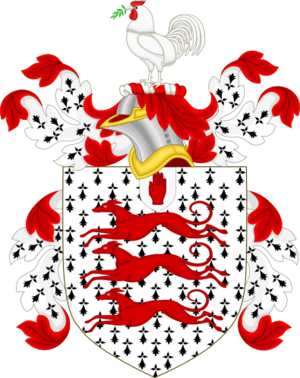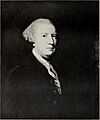Sir Henry Moore, 1st Baronet facts for kids
Quick facts for kids
Henry Moore
|
|
|---|---|

Portrait of Moore by Joshua Reynolds
|
|
| Governor of New York | |
| In office 1765–1769 |
|
| Monarch | George III |
| Preceded by | Cadwallader Colden |
| Succeeded by | Cadwallader Colden |
| Personal details | |
| Born | 7 February 1713 Vere Parish, Jamaica |
| Died | 11 September 1769 (aged 56) New York, New York |
| Signature | |
Sir Henry Moore (born February 7, 1713 – died September 11, 1769) was an important leader in the British colonies. He was born in Jamaica. He became the governor of New York from 1765 until he died in 1769. Before that, he was the acting governor of Jamaica several times. He also received a special title called "Baronet" in 1764.
Contents
Early Life in Jamaica
Henry Moore was born in Jamaica on February 7, 1713. His family was important and owned large farms. They made sure he received a good education in law. As an adult, Moore started working for the colonial government in Jamaica.
Leading Jamaica
In 1756, Henry Moore became the lieutenant governor of Jamaica. This meant he was the acting governor of the colony. At that time, the main governor often stayed in Britain. So, the lieutenant governor and a local council ran things.
Stopping a Rebellion
In 1760, Moore became well-known for his strong leadership. He helped stop a large slave rebellion called Tacky's War. Moore asked for help from the Jamaican Maroons. These were groups of people who had escaped slavery and lived in free communities. The Maroons from Nanny Town, Charles Town, and Scott's Hall joined the colonial forces. Together, they helped put an end to the revolt. Some say Nanny Town was even renamed Moore Town to honor him.
Governing New York
Because he did such a good job in Jamaica, Henry Moore was first made a Baronet. Then, in 1764, he was chosen to be the royal governor of New York. He arrived in New York City with his family in November 1765.
Easing Tensions
When Moore arrived, things were tense between the colonies and England. The previous governor, Cadwallader Colden, had faced many problems. New York City had seen protests and riots over the Stamp Act. This law made colonists pay a tax on printed materials.
Governor Moore worked to calm the situation. He met with Isaac Sears, a leader of the Sons of Liberty. This group was against British taxes. Moore agreed with Sears and the colony's assembly to try and stop the Stamp Act. He also gained trust by reducing military buildings in the city. His friendly approach made him popular. While other governors were being protested, Moore was praised.
Dealing with Rural Unrest
However, in the next few years, Moore used military force. He stopped riots by farmers who rented land from wealthy owners. He ordered General Thomas Gage to stop these rural rebellions. This did not cause him problems with the city leaders. The Sons of Liberty did not want rural problems to spread to the city. They felt only they should use protests to get what they wanted. Also, the assembly was controlled by the "patroons." These were the rich landowners.
In December 1767, Moore even closed the assembly for a short time. This allowed the patroons to gain more power in new elections.
Later Life and Legacy
Henry Moore married Catherine Maria Long in 1765. She was also from an important family in Jamaica. They had several children. After Henry's death, Catherine moved to England. A mountain peak in Jamaica, Catherine's Peak, is named after her. Local stories say she was the first woman to climb it.
Moore died suddenly in New York City in 1769 while still in office. His duties then went to Lieutenant Governor Cadwallader Colden. Colden's time as governor was much less peaceful. Moore was respected by most leaders in the colony. Only some religious groups were upset because he tried to create a theater. His son, John Henry Moore, became the 2nd Baronet at age thirteen. He died in 1780 when he was 23.
Images for kids
-
Portrait of Moore by Joshua Reynolds




